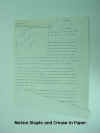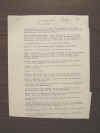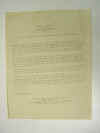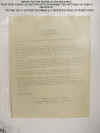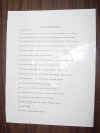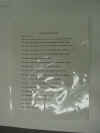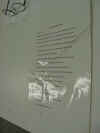My Personal Experiences
Beginning Conservation & Preservation
Where do I start what do I do?
Click on images for larger view!
If you already have a repository and many items filed and put away. You might find as a new Archivist/Historian that you don't have a clue as to what you should do, to preserve these documents or items so that our past might be protected. For the future people who have an interest in what others have already worked through and the avenues that they took to achieve the results they got.
At my first 3rd National Archives Workshop in Akron Ohio, one of the first things I learned was very simple and powerful.
" Don't do anything to any item that cannot be undone."
Simply put I learned to take the approach that these documents might not be important to me, but they may mean the world to someone else. So with this in mind I have to be responsible and recognize that this seemingly meaningless document or item doesn't have much significance to me, but it may tie the pieces together for someone else many years from now. My first archival work began with my Home Group. There were flyers, events, documents that pertained to my group. Of course these mean everything to me because I'm familiar with the people involved the surroundings and the events. So when I began to put efforts in the preservation of my group's history it opened up many folders. First I had to look in my district. There were many different Groups involved. As I dug thru the District folders and finally arrived at my Home Group the past began to come alive. I recognized the names of some of the people that I had heard about many years. I didn't know them personally but it felt as if I did. They were the ones that had taken the not so important insignificant papers and flyers and minutes and problems and solutions and saved them for what eventually would become a part of some Area Archives. These people realized the importance of the struggles they had in making Group, District or Area decisions. They had walked thru these things with both good and bad results. They had argued over coffee prices and telephone bills and how are we going to pay next months bills over and over month after month and even year after year. These documents become the very soul of not making the same mistake over and over again. Thus Archives. If we will only utilize our past and preserve it as it was, not as we perceive it was. In other words the other simple but powerful statement I learned was the responsibility of each of us.
" Lets Keep The Record Straight"
Below you will find a few tidbits of information that hopefully will help you and your repository.
As I began to dig thru the folders to get to what I was looking for I noticed several things.
1:Folded and creased papers.
2: Legal size papers folded in standard size files.
3: Staples beginning to rust.
4: Yellowed or smoke saturated papers.
5: Documents from wrong groups in wrong folders.
6: Numerous copies of the same document in many of the folders.
7: Paper Clips and the damage that they can do.
8: Folders and Filing Cabinets overstuffed.
9: Handwritten dates and other info added to documents possibly by whomever filed papers.
10:Lamanated documents with no way for future preservation.
Staples begin to rust after a few years. Sometimes much quicker than others. The quality of staple alone might last many years longer before it begins to deteriorate than others. So as preservationists, historians or archivists we should try to take a look at the long term effects of things. When we access a folder we might see the many things mentioned above. If time will allow we would like to address as many issues as possible while in the folder and preserve the items in the particular folder as best we can at the time. Time never seems to co-operate with us though. So we have added a few tidbits for temporary relief when accessing a folder below. This is a very time consuming effort. Our Repository alone has several hundred folders that need to be accessed and a more long term preservation applied.
Keep in mind that you might have just accessed a folder that might not be accessed again for many years.
Apologies for the quality of above pictures, but you can get the idea.
Why remove staples?
Take a close look at the beginning of the rusting staple.
Then after removal look at the paper and the beginnings of the deterioration the staple has caused the paper.
Another Example of Staple Rust & Removal
If this access is the only one for many years, then the reason for removing staples should be obvious. The photos above will let you see the very beginnings of deterioration caused by the breakdown of staples. It isn't very hard, just time consuming to remove staples. Especially in the more precious documents. The ones that are important to you. I prefer to use a small pocket knife. Although they make staple removers of various types. I tend to be an extremist and don't want to do any more damage to the paper than I have too. Some staple removers may cause additional damage. So choose what works best for you. Experiment on documents that wont matter.
Notice on the photos above the staples, the handwritten date, the crease's and folds in the paper.
How much of this damage can be avoided?
The legal size papers that were in standard folders were un-folded and put in legal size folders.
The staples were removed and plastic clips were added. Although I have some concern about adding the plastic clips. They seem to do more creasing damage to paper than say a standard wire paper clip.
What you might find when accessing a folder of your Home Group.
View of folder that has plastic clip and folded paper.
How many things can you see that might need attention to preserve this folder?
Notice the yellowing of the paper and the again handwritten date on this document.
Is this yellowing normal for a document from 1973?
Or is this smoke damage?
Or possibly acidic?
Did the previous Archivists/Historian research the date of material and pencil it in?
What is the best way to permanently mark dates and pertinent information on any document without doing irreversible damage?
The temporary action taken with this document was the use of a ph testing pen. As fate would have it I tested it on the front of the document in a very obvious place. Thus a learning experience. Always test in the least conspicuous place and on the back of the document. Because it is not suggested to encapsulate a acidic document without de-acidifying it first. It was decided to put in a archival quality sleeve as a temporary effort of preservation.
I have found out that you need plenty of work space when your preservation begins. It seems that once you get started and open a folder many things begin to be obvious even to the novice. This is why the above working space seems so cluttered.
Notice that laminating is very tricky and has few uses in preserving a very precious document.
We should strive as stated above to never do anything that cannot be un-done.
Lamination is Permanent.
Don't Do It.
Folder Access Suggestions
When your Archivist/Historian access's a particular folder, they might take the time necessary to do just a few things that will help to insure the continued life of your repository. Remember when you access material, it is not foolish to think that this folder might not be accessed again for many years. So it might be wise to think about the following suggestions.
1: Remove staples and metal paper clips. (Replace with coated or plastic clips.)
2: Remove un-related material and place properly.
3: Remove anything more than duplicates and place or distribute properly.
4: Try to keep all pertinent documents together.
5: Ph test on backs of documents that are in question.
6: Straighten all crease's and folds.
7: Older or more fragile precious documents might be put in archival quality polyester sleeves.
Notes and examples:
1: The coated paper clips seem to work the best. Unlike the plasti clip the coated paper clips don't seem to crease and damage the papers as bad.
2: Un-related material might be District 10 material in District 32 folder. etc.
3: Many times there may be several of the same documents in a single folder. Two of the best copies might be preserved/archived and the others distributed to the Area or District or Group to which they pertain.
A folder for Duplicates might be compiled and occasionally distributed properly.
4: Say for instance a Old Member passes on and their family donates all their AA related material to an Area Archives. In this case if it is possible it would be nice to keep these items together.
5: Obviously this leaves a mark. So in the least conspicuous place would be the best place to test.
6: Use a bone folder or something similar to un-fold and straighten out best you can. Re-stack papers neatly.
7: Of course more precious documents that are fragile or maybe acidic would need a little closer examination. It might be wise to add the more fragile documents into a archival quality sleeve for a little added protection.
8: It is also wise to copy fragile or acidic documents and label as (COPY) for future Archivists/Historians.
Revised 12/03/2005








